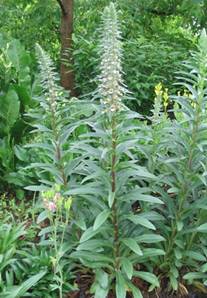Digitalis (Digitalis lanata Ehrh.)
Scrophulariaceae
Varieties
Strain E.C. 115996 is reported to have higher foliage yield with high glycoside content
Soil and climate
A well drained sandy soil rich in organic matter and slightly acidic (pH 5.5 – 6.5) in reaction is suitable. It requires a cool and mild climate (20 – 30°C) and comes up well in hill slopes at elevation of above 1250m Mean Sea Level.
Planting season
Planting spreads from May – June for direct sowing and February for nursery sowing.
 |
Digitalis lanata |
Seeds and sowing
It can be propagated by seeds.
Seed rate
The optimum seed rate is 8 kg/ha for direct sowing and 2 kg/ha for transplanting.
Spacing
It can be planted at a spacing of 45 x 30 cm.
Manuring
Apply FYM 10t/ha and NPK 20:30:30 kg/ha respectively as basal dose. Again N 150 kg/ha is applied as top dressing in 4 equal splits at 3 months interval.
Aftercultivation
Give 1 - 2 weedings in the initial stages.
Plant protection
Leaf spot and leaf blight
It can be controlled by spraying Mancozeb 2g/l.
Harvest
Harvesting extends upto 2 years. 8 - 10 cm long leaves (excluding petiole) are collected between July and August from the first year crop and second harvest taken one and half months later. Dry the leaves by passing hot air at 60°C. About 2 - 3 harvests can be done during the first year and 2 harvests during the second year.
Yield
About 2000 - 3000 kg of dried leaves/ha can be obtained. The active principle in dried leaves ranges about 0.44 to 0.71 per cent.
Source
1. http://www.robsplants.com/images/portrait/DigitalisLanata050604a.jpg |

